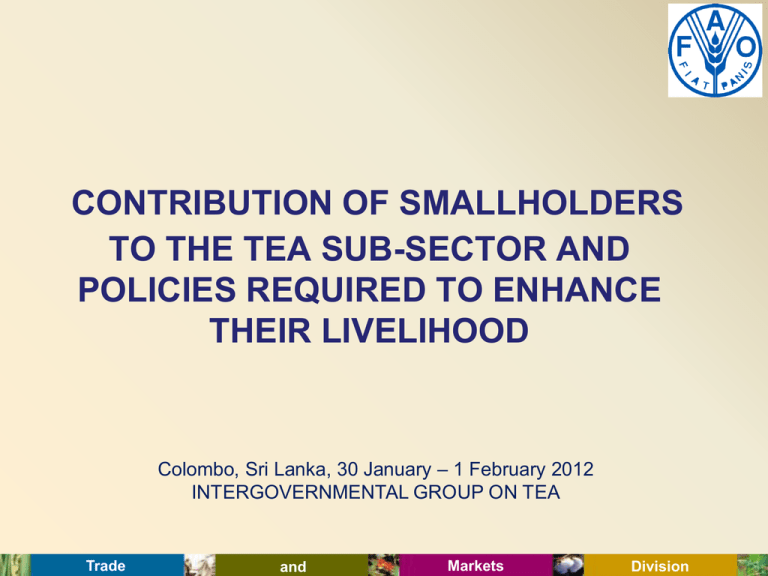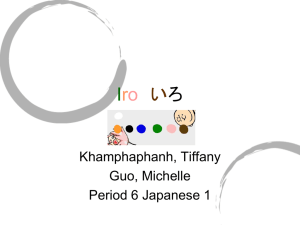CONTRIBUTION OF SMALLHOLDERS TO THE TEA SUB-SECTOR AND POLICIES REQUIRED TO ENHANCE
advertisement

CONTRIBUTION OF SMALLHOLDERS TO THE TEA SUB-SECTOR AND POLICIES REQUIRED TO ENHANCE THEIR LIVELIHOOD Colombo, Sri Lanka, 30 January – 1 February 2012 INTERGOVERNMENTAL GROUP ON TEA Trade and Markets Division Introduction CCP: TE 12/4 • The emphasis on smallholder development is in line with FAO's strategic objectives and an important millennium development goal (MDG). • The last comprehensive review of smallholder tea sector was carried out by the Group at its 12th Session in 1997 in Indonesia. At that review the analysis indicated that the welfare of smallholder tea producers was much greater than their counterparts in other agricultural enterprises in the countries that the Secretariat surveyed, namely Indonesia, Kenya, Sri Lanka, and Tanzania. 2 Trade and Markets Division Definition • Smallholders play an important role in the tea sub-sector. There are more than 400 000 smallholders in Sri Lanka who account for 76 percent of tea production, produced in 64 percent of the area under tea. • In Kenya, an estimated 560 000 smallholders account for 62 percent of total tea production, while in China and Vietnam, tea production is essentially dominated by smallholders. • In Indonesia, smallholders account for 43 percent of the area under tea and 23 percent of production. • In India, an estimated 160 000 smallholders account for over 26 percent of its production 3 Trade and Markets Division Major issues • In countries and regions where smallholders do not have collective ownership of factories and regulations and institutions do not intervene, they are left to the vagaries of an un-organized imperfect market for green leaves. • Many Governments have attempted to regulate the system of payments to smallholders by private processing factories, against those that are collectively owned as in Kenya. Examples of successful systems can be found in Sri Lanka and Indonesia. 4 Trade and Markets Division Major issues • In Sri Lanka the price sharing ratio between smallholder and factory has evolved from the initial 75:25 to 68:32 • Implementation is through a system of “tea inspectors” who closely monitor the tea factories purchasing green leaves from smallholders and the price paid to them, based on the actual realization for the tea sold in the auctions. • The Tea Board of India introduced in early 2004 a pricesharing formula based on the Sri Lankan model. The price-sharing formula envisaged that the sale proceeds was to be shared between the smallholder and the manufacturer-processor in the ratio of 60:40 Trade and Markets Division 5 Major issues • There is a need to develop strong partnerships with quality tea processing factories and with international buyers so that the smallholder could also fit into a high-quality supply chain with full traceability of his product. • China, India, as well as other emerging international markets in the Middle East and Eastern Europe are moving towards higher quality standards that are prevalent today in economically advanced regions. Smallholders, in order to participate and compete in such markets have to develop capacities ensuring internationally acceptable and certified quality. 6 Trade and Markets Division De-estating • The phenomenon of fragmentation of large estates (or ownership change in favour of the workers) has taken place historically in restructuring exercises by Government policy, as a process of natural attrition due to long spells of closure, or by corporate policy. • In Sri Lanka, all private plantations were nationalized by the Government in the 1970s. Following a policy change in the 1990s, it was decided to parcel out gardens belonging to two State corporations and hand them over to private regional plantation companies under a profitsharing arrangement. In the process of sale and allocation of shares, the Government ensured that the workforce was also given a chance to hold shares 7 Trade and Markets Division De-estating - Cont • The problem of large abandoned gardens is that once the owners wash their hand off their properties, there is a tendency among workers to divide the lands among themselves in terms of plucking green leaves and selling the same to neighbouring estates and stand-alone factories. In India, this informal arrangement sustained several estates that were closed during the period of severe recession from 2001 onwards but the workers neither had the land titles nor is this model worthy of emulation. 8 Trade and Markets Division De-estating - Cont • At the other end, Tata Tea Limited decided to concentrate only on its packet tea business as an explicit corporate policy and proceeded to divest its majority stake in its gardens in Munnar, South India, and passed on the majority ownership (76 per cent) to the 12,000 workers. A new entity, Kanan Devan Hills Plantations Company Private Limited (KDHP) succeeded Tata Tea Limited on 1st April 2005.The property remained intact and the management continued to be professional. The company is today the largest in South India with 7 estates covering 24,000 hectares and with an annual production of 21 million kilograms. The sense of ownership led to a significant increase in productivity and profits (and dividends to the worker-owners). Trade and Markets Division 9 De-estating - Cont • There is an earlier example in India of a successful workers’ cooperative in Durgabari in Tripura, North East India where after the owners abandoned the property, the workers took over the management and formed a cooperative society. While a good deal of State funding and support has contributed to the success, strong management has played a key role as well. 10 Trade and Markets Division De-estating - Cont • What are the policy options where existing large tea estates require to be restructured due to lack of viability? If State intervention or Government subsidy is to be least and the long-term business viability is to be ensured, the Tata Tea experiment can be suitably adopted. Unfortunately, however, most restructuring has to take place because the concerned estates are financially sick and the field and factory assets in poor condition. 11 Trade and Markets Division Conclusion and follow up • Smallholders represent the major part of the tea subsector across producing countries with high growth in the past decade, even in countries where the corporate estates is still of significance. • However, due to the small size of their average holding, high level of transaction cost, limited opportunities for capacity building and varying institutional support, coupled with poor bargaining power in the green-leaf and input markets, smallholders have not been able to reach full realization of their true worth 12 Trade and Markets Division Conclusion and follow up • Policies have to empower and not make smallholders dependent on Government-sponsored institutions in the long run. Smallholders need to be well-represented in all institutions that are set up and/or are formed. • In countries which still have a large corporate sector, smallholders may be encouraged to set themselves up in a complementary role and enter into mutually beneficial partnerships. Similar partnerships with large international buyers and organizations encouraging socially and environmentally sustainable production of tea could also ultimately benefit the sub-sector. 13 Trade and Markets Division Finally • The Group is requested to guide the Secretariat in prioritizing the areas that need to be analyzed to evaluate the welfare of smallholders. In addition, suggest areas for further research to improve the participation of smallholders in the global tea economy and instruments to be analyzed in support of enabling policies that may enhance their welfare. 14 Trade and Markets Division Thank You Trade and Markets Division



